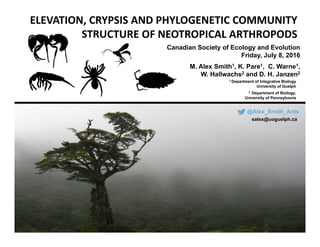
Smith et al CSEE 2016
- 1. ELEVATION, CRYPSIS AND PHYLOGENETIC COMMUNITY STRUCTURE OF NEOTROPICAL ARTHROPODS Canadian Society of Ecology and Evolution Friday, July 8, 2016 @Alex_Smith_Ants salex@uoguelph.ca M. Alex Smith1, K. Pare1, C. Warne1, W. Hallwachs2 and D. H. Janzen2 1 Department of Integrative Biology University of Guelph 2 Department of Biology, University of Pennsylvania
- 7. Dry forest Rain forest Cloud forest Collection Localities Área de Conservación Guanacaste In an area ~3.5x the area of the city of St. John’s there are estimated to reside 3% of the world’s biodiversity
- 9. R² = 0.9611 17 22 27 32 37 0 500 1000 1500 Average Daily Max: Temp (°C) 10 15 20 25 30 35 40 45 04‐Dec‐12 04‐Dec‐13 04‐Dec‐14 04‐Dec Daily Max: Temp (°C)
- 10. Questions: • Who lives where? • How much overlap? • Is this changing? • Functional:phylogenetic?
- 12. Elevational Range An example with Gnamptogenys ants • Most species found at only 1 site • Small number of sp. with a range
- 13. Elevational Range An example with Collembola • Some species found at only 1 site • Larger number of sp. with a range
- 15. • So there is strong genetic differentiation at a fine spatial scale. • Is there corresponding functional diversity? • “Ant space”
- 18. F= 3.81, df=2, p=0.023
- 20. Morphospace along an elevational gradient • Largest “ant‐space” occurs with the greatest diversity • Dry & cloud forest occupy a subset of this “ant‐space” • These subsets represent smaller body measurements of features that are functionally associated with predation. • This does not bode well for the future. • The largest “Collembola‐ space” occurs in the dry forest. Not more diverse. Range of ranges. • Rain & cloud forest occupy a different portion of this “Collembola‐space” • Traits here are those associated with life at the surface.
- 21. 1. Turnover: extremely small communities • Climate change is affecting and will continue to affect turnover. • Vulnerable, vulnerable vulnerable! 2. Degree of coupling between genetic divergence and morphospace is not simple • Related in ants, not so much in Collembola 3. What next? • Community characterisation • Expansion of functional traits (ie. related to abiotic variables of thermal ecology) • Taxonomic expansion Messages
- 22. Acknowledgements • The ACG for protecting it all! • The ACG parataxonomists for collecting, rearing and databasing ACG insects. • ALL the graduate and undergraduate students and volunteers in the Smith Lab for their enthusiasm, questions, dedication and love for the little things. • NSERC Discovery Grant to MAS @Alex_Smith_Antssalex@uoguelph.ca
- 23. Come & work with us! http://malexsmith.com/ Chris Ho
